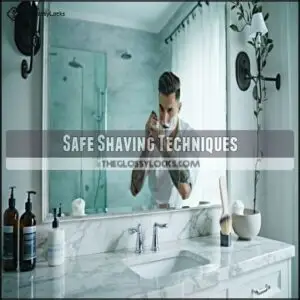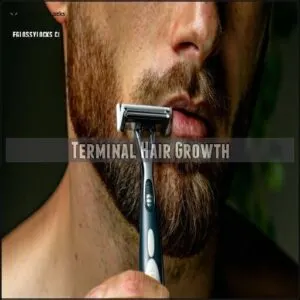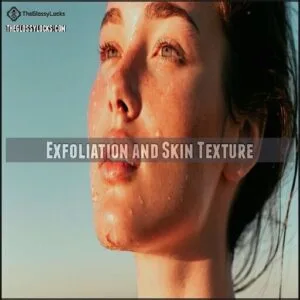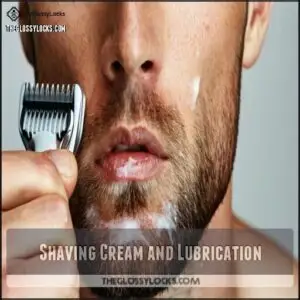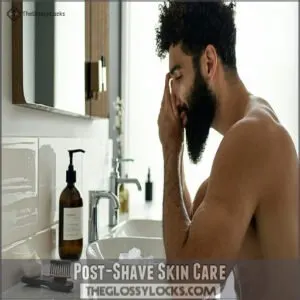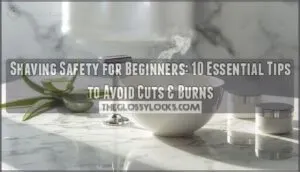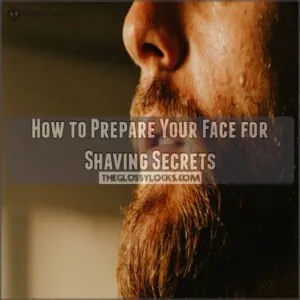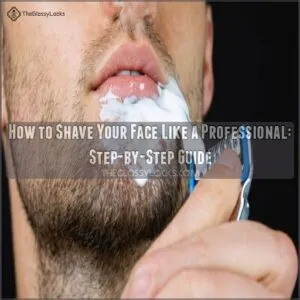This site is supported by our readers. We may earn a commission, at no cost to you, if you purchase through links.
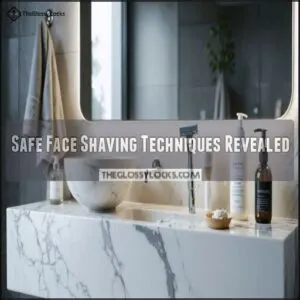 To master safe face shaving techniques, start by prepping your skin with warm water and gentle exfoliation—think of it as clearing the runway for a smooth takeoff.
To master safe face shaving techniques, start by prepping your skin with warm water and gentle exfoliation—think of it as clearing the runway for a smooth takeoff.
Use a sharp razor with an ergonomic handle for control, and shave with the grain to avoid nicks and ingrown hairs. Keep the razor at a 30-degree angle, applying light pressure, because your face isn’t a hardwood floor.
Sensitive skin? Opt for pre-shave oils and alcohol-free moisturizers to reduce irritation.
Finish with a hydrating balm and sunscreen to protect your skin. Curious about avoiding razor bumps or managing tricky areas? Stay tuned for more tips.
Table Of Contents
- Key Takeaways
- Safe Shaving Techniques
- Facial Hair Growth Patterns
- Shaving Best Practices
- Shaving Safety Considerations
- Post-Shave Skin Care
- Frequently Asked Questions (FAQs)
- What is the safest way to shave your face?
- Do dermatologists recommend face shaving?
- Is it okay to shave peach fuzz on your face?
- Are you supposed to shave up or down on your face?
- How to clean razors for maximum hygiene?
- Can shaving affect facial skin elasticity?
- What are alternatives to shaving cream?
- How to prevent razor corrosion over time?
- Does diet influence facial hair growth?
- Conclusion
Key Takeaways
- Prep your skin with warm water, gentle exfoliation, and pre-shave oils to reduce irritation and ensure a smooth shave.
- Use a sharp razor at a 30-degree angle and shave with the grain using light pressure to avoid nicks and ingrown hairs.
- Apply a hydrating aftershave balm and sunscreen post-shave to protect and soothe your skin.
- Clean and store your razor properly to maintain hygiene and prevent rust or bacteria buildup.
Safe Shaving Techniques
You’re about to learn the safe shaving techniques that will help you achieve a smooth, comfortable shave.
By following these tips, you’ll be able to shave with confidence, reducing the risk of nicks, cuts, and irritation, and getting the best results for your skin type.
Pre-Shave Skin Preparation
To prep your skin, try these steps:
- Exfoliation methods
- Skin cleansing
- Warm water prep
- Facial massage.
Proper pre-shave skin preparation is essential for all skin types.
Use pre-shave oils for healthy skin, especially shaving for sensitive skin, to achieve a smooth shave with proper skin preparation and preshave care.
Choosing Right Razor Blades
Choose razor blades wisely, considering blade materials, sharpness, and edge retention.
A sharp blade, like a safety razor, is key to a safe shave.
Handle ergonomics and blade coating also matter.
Prioritize sharp blades for a smooth experience, and remember, razor blade care is essential for ideal performance and safety.
Understanding razor blade sharpness factors can help in making informed decisions when selecting a razor.
Shaving With The Grain
When shaving, consider the grain direction to avoid nicks.
Here are tips:
- Identify hair patterns
- Hold razor at 30-degree angle
- Use gentle strokes
- Maintain blade sharpness
These tips are crucial for safe shaving techniques and to achieve smooth results, so always shave with the grain.
Facial Hair Growth Patterns
You’ll want to understand your facial hair growth patterns to shave safely and effectively.
By knowing how your hair grows, including the differences between vellus and terminal hair, you can adjust your shaving technique to minimize irritation and get a smoother shave.
Vellus Hair Characteristics
You’ll notice vellus hair, a fine texture, as facial fuzz or peach fuzz.
This fine hair helps regulate body temperature.
Vellus hair characteristics include being short, thin, and soft.
| Vellus Hair | Fine Texture | Hair Regrowth |
|---|---|---|
| Soft | Thin | Slow |
| Light | Short | Variable |
| Translucent | Delicate | Unpredictable |
The characteristics of vellus hair, including being delicate, contribute to its role in the body.
Terminal Hair Growth
You’ll find terminal hair is thicker, darker.
Here are key points:
- Hair Follicles
- Growth Patterns
- Hormonal Influence
- Thickening Methods
- Regrowth Rates
For safe shaving techniques, consider terminal hair growth when shaving your face, following the direction of hair growth, to achieve effective results.
Genetic Influences on Hair Growth
You see, genetics play a role in hair growth.
| Hair Growth Genes | Follicle Sensitivity |
|---|---|
| Hormone Influence | Ethnicity Factors |
| Age-Related Changes | facial hair |
| hair growth | shaving techniques |
| skin types | direction of hair growth |
The table outlines various factors influencing hair growth, including Hormone Influence and other elements such as age, ethnicity, and skin types.
Shaving Best Practices
You’re about to learn the best practices for safe face shaving, which will help you achieve a smooth shave while minimizing irritation and ingrown hairs.
By following these tips, you’ll be able to shave with confidence, using the right techniques, such as exfoliation, proper razor angle, and gentle pressure, to get the best results for your skin.
Exfoliation and Skin Texture
You prepare your skin with exfoliation, using skin exfoliants or facial scrubs to remove dead skin, minimizing pores and improving texture, which helps reduce skin irritation, especially for sensitive skin, making your shaving technique more effective and safe, promoting healthy skin care.
Effective exfoliating face care is essential for achieving the best results.
To achieve the best results, follow these steps:
- Exfoliate regularly
- Use gentle products
- Moisturize afterwards
Shaving Cream and Lubrication
A good shaving cream provides proper lubrication, reducing friction for a smooth shave.
Choose types suited to your skin—sensitive formulas or hydrating options work wonders.
Apply shaving cream evenly using circular lather techniques for better coverage.
For safe shaving tips, don’t skip this step—alternatives like shaving gel or oil can also provide excellent shaving lubrication and protection.
When shaving, using the right sensitive skin care techniques can make a significant difference in reducing irritation.
Razor Angle and Pressure
A smooth shave starts with the right cutting angle and light pressure.
Hold the razor at a 30-degree shaving angle, letting it glide effortlessly. Avoid pressing too hard—your razor blade should do the work. Keep skin tension steady using your free hand.
Follow these tips:
- Shave with the grain
- Use short shaving strokes
- Rinse frequently
- Maintain razor alignment
- Prioritize safe shaving techniques to ensure a smooth shave, remembering that your razor blade should do the work.
Shaving Safety Considerations
You’ve got to keep your skin’s needs in mind to shave safely and avoid irritation.
From sensitive skin to dryness or existing conditions, a few small adjustments can make all the difference, considering complete concepts to ensure the best results.
Sensitive Skin and Irritation
If your skin feels like it’s auditioning for a drama series after shaving, you’re not alone.
Shaving for sensitive skin means using gentle shaving techniques, hypoallergenic products, and avoiding too much pressure.
To reduce irritation and prevent razor burn, go with the grain and keep strokes light.
A soothing aftershave can calm skin irritation and help prevent pesky ingrown hairs.
Dry Skin and Hydration
A parched face needs special attention when shaving.
You’ll want to hydrate your skin thoroughly before picking up that razor. Start with warm water to open pores, then apply a hydrating pre-shave oil.
When shaving, use a moisturizing cream that won’t strip your skin’s natural oils.
After you’re done, lock in moisture with an alcohol-free, hydrating aftershave balm for ideal skin renewal. Understanding skin hydration methods is essential for maintaining healthy and soft skin.
Skin Conditions and Shaving
Beyond hydration, you’ll need extra care if you’re dealing with skin conditions.
While eczema and rosacea can make shaving tricky, you don’t have to give up your grooming routine.
Consider consulting a dermatologist who can recommend specific products and techniques, they’ll help you navigate around sensitive areas, minimize skin irritation, and prevent complications like folliculitis or razor burns.
Watch for signs of infection and adjust your routine accordingly.
Post-Shave Skin Care
You’ll need to protect your freshly shaved skin from irritation, redness, and ingrown hairs with the right post-shave care routine.
After you’ve finished shaving, you can keep your skin smooth and healthy by applying an alcohol-free moisturizer, followed by a broad-spectrum sunscreen for outdoor protection.
Aftershave Balm and Moisturizing
After safeguarding your face during shaving, you’ll want to lock in that protection with proper aftershave care. Choose an alcohol-free balm that’s packed with soothing ingredients like aloe or chamomile.
Pat your face dry gently, then apply your aftershave cream in upward strokes. For best skin hydration, follow up with a moisturizer that matches your skin type – your face will thank you later.
Using a high-quality Aftershave Balm can provide additional benefits to your skin care routine.
Reducing Ingrown Hairs and Irritation
After moisturizing, focus on preventing ingrown hairs and irritation. A good shaving technique matters—use sharp blades, shave in the direction of hair growth, and keep strokes light.
Exfoliation clears dead skin, letting hair grow freely. Proper aftercare reduces razor burn and soothes sensitive skin.
- Use a warm towel to soften skin.
- Avoid dull razors entirely.
- Moisturize daily for smoother results.
- Pause shaving if irritation persists.
Sunscreen and Skin Protection
After soothing your skin, don’t skip sun protection.
A facial sunscreen with UV protection shields against sunburn and reduces skin cancer risks. Choose a daily moisturizing formula that hydrates while defending your skin health.
Postshave moisturizer with SPF blends seamlessly into your skincare routine, keeping irritation at bay. Think of it as armor for your freshly shaved face, providing a layer of protection that is essential for skin health and preventing skin cancer risks.
Frequently Asked Questions (FAQs)
What is the safest way to shave your face?
Think of your face as a canvas—prep it with warm water, exfoliate gently, and use shaving cream.
Shave with the grain, light strokes, and a sharp razor.
Rinse with cool water, then moisturize.
Do dermatologists recommend face shaving?
Dermatologists often say face shaving is safe if done correctly.
It’s great for exfoliation and removing peach fuzz.
They recommend proper prep, sharp razors, and shaving with the grain to avoid irritation.
Is it okay to shave peach fuzz on your face?
Yes, shaving peach fuzz is fine.
It’s mostly vellus hair, so removing it won’t make it grow back thicker.
Use a clean razor, shave gently with the grain, and moisturize afterward to avoid irritation.
Are you supposed to shave up or down on your face?
Shave with the grain (downward) to reduce irritation and ingrown hairs.
Going against the grain (upward) can give a closer shave but increases risks, so save that for touch-ups if your skin tolerates it.
How to clean razors for maximum hygiene?
Did you know razors can harbor up to 5 million bacteria?
Rinse yours thoroughly after each use, soak it in rubbing alcohol weekly, and store it dry to avoid rust.
Clean razor, happy skin!
Can shaving affect facial skin elasticity?
Shaving doesn’t directly impact skin elasticity, but improper techniques, like aggressive strokes or skipping moisturizer, can irritate and stress your skin over time.
Treat your face gently—your skin’s not a punching bag!
What are alternatives to shaving cream?
When you’re in a pinch, swap shaving cream for coconut oil, aloe vera gel, or even hair conditioner.
They provide a smooth glide, reduce irritation, and hydrate your skin—just don’t grab the peanut butter!
How to prevent razor corrosion over time?
Store your razor in a dry spot, not the shower.
Rinse it thoroughly after use, pat it dry with a towel, and apply a light coat of mineral oil to prevent rust.
Simple, right?
Does diet influence facial hair growth?
While genetics play a significant role, you’ll find that diet can influence facial hair growth, with nutrients like protein, iron, and biotin supporting healthy hair development, don’t you think?
Conclusion
Think of safe face shaving techniques as building a strong foundation for healthy skin.
When you prep properly, use the right tools, and follow the grain, you’ll avoid common pitfalls like nicks and irritation.
Pay attention to your skin type—sensitive or dry—and adjust your routine with gentle products like pre-shave oils and hydrating balms.
Don’t forget sunscreen to protect your skin after shaving.
Stick to these steps, and you’ll keep your face smooth, comfortable, and razor-bump free.
- https://carbonshavingco.com/blogs/resources-and-blog/ultimate-guide-to-preparing-your-skin-and-face-for-shaving-expert-tips-and-natural-ingredients
- https://www.aad.org/news/tips-for-men-how-to-shave
- https://skinkraft.com/blogs/articles/how-to-care-of-your-skin-after-shaving
- https://aphconnectcenter.org/visionaware/living-with-blindness-or-low-vision/self-care/personal-care/shaving-your-face/
- https://www.healthline.com/health/women-shaving-face

